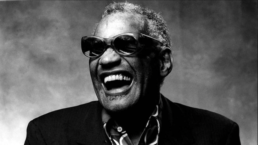These life stories may contain descriptions of childhood trauma and abuse, as well as images, voices and names of people now deceased. If you need help, you can find contact details for some relevant support services on our support page.
Legendary African American singer and songwriter, Ray Charles (1930-2004), was in foster care at the age of fifteen for twelve months.
Ray Charles Robinson was born to Bailey Robinson and Aretha (Retha) Williams. Retha was fostered by Bailey’s family in Greenville, Florida and made Robinson her surname. She left the Robinsons after she got pregnant, because of the scandal. After a couple of months, Retha returned to Greenville with her baby, and Bailey’s wife, Mary Jane, helped with child care. Bailey abandoned his family.
By the time he was twelve months old, Ray had a brother, George, and the boys were close. George drowned in 1935 and not long after, Ray began having trouble with his eyes; he was blind by the time he was seven.
Retha insisted the boys help out from an early age, a practice she continued after Ray became blind.
In 1937, Retha made the decision to send her son to the Florida School for the Deaf and Blind.
The state paid room, board, and tuition, plus train fare to and from in the fall and spring. It wouldn’t cost Retha a thing. She could put RC on a train, the conductor would keep an eye on him, and a teacher from the school would meet him at the station in St. Augustine (Lydon,12).
Initially, Ray did well in the classroom, but was unhappy. He had begun six weeks into term and poverty meant he got around barefoot and was teased for that, and for missing his mother.
After the first term, Ray settled in more and enjoyed his time. By the age of eight he had decided to be “a great musician” and lapped up everything he was taught at school while also singing in a chorus and hanging out with other students who liked jazz.
Retha died from cancer in 1945; she was only thirty-one. Ray returned to school after the funeral but he was soon in trouble and expelled.
May Jane Robinson told the boy about a friend of hers who worked as a maid in Jacksonville and lived with her sister and brother-in-law. Louise said the Thompsons would take him in.
Jacksonville was a bigger city than St. Augustine or Tallahassee; maybe there he could make some money playing music. RC made up his mind: he would go to Jacksonville, live with the Thompsons, and see what happened next (Lydon, 26).
Lena Mae and Fred Thompson took in fifteen-year-old Ray Charles and made him a part of the family, offering to buy him clothes and give him an allowance. Ray, however, wanted to earn his own money as a musician as soon as he could. Within twelve months he was able to pay his way.
Sixteen-year-old Ray Charles headed first to Orlando and then to Tampa.
That RC chose to rely on himself at sixteen is noteworthy: few reach this turning point so young, fewer still who are blind. It also stands as a first clear example of many such choices to come. From Orlando onward, when faced with dependence one way, independence another, Ray Charles will, with rare consistency, choose independence (Lydon, 40).
After playing piano for others, and struggling with poverty at times, Ray formed his own band, and had significant success with the recording, ‘Confession Blues’. He moved to Los Angeles in 1950 and from then his career took off.
By 1954 Charles had created a successful combination of blues and gospel influences and signed on with Atlantic Records. Propelled by Charles’s distinctive raspy voice, “I’ve Got a Woman” and “Hallelujah I Love You So” became hit records. “What’d I Say” led the rhythm and blues sales charts in 1959 and was Charles’s own first million-seller (Britannica).
Ray Charles was brought to Australia by promoter, Glenn Wheatley, three times, the last time in 2002.
Mr Wheatley said his fondest memory of Charles was when he persuaded him to perform John Lennon’s Imagine with John Farnham and Kylie Minogue at the opening of Crown Casino in 1997. But some of the most magical performances were at sound checks. “He would sit in his chair, find the safety net of his piano, find his incredible pitch and just play around. It was awesome” (The Age).
Ray Charles received many awards, including thirteen Grammies and a lifetime achievement in 1987. He published an autobiography in 1978, was inducted into the Rock and Roll Hall of Fame in 1987, and posthumously into the Country Music Hall of Fame in 2022.
References:
Lydon, Michael. Ray Charles. Man and Music. New York: Routledge, (2004).
“Ray Charles American Musician.” Encyclopaedia Britannica. https://www.britannica.com/biography/Ray-Charles
“Ray Charles leaves the road behind.” The Age, 12 June 2004. https://www.theage.com.au/entertainment/celebrity/ray-charles-leaves-the-road-behind-20040612-gdy0td.html
Image available here.
